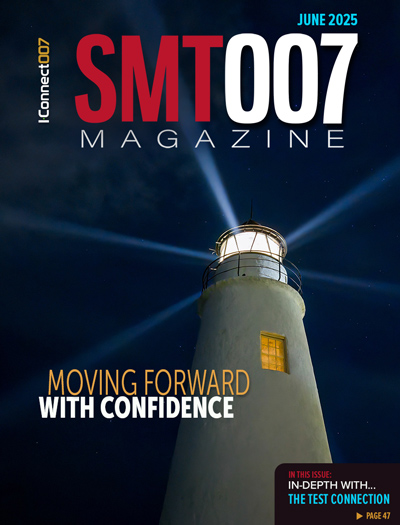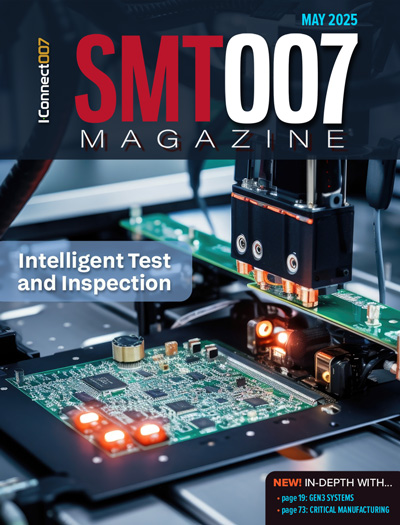-

-
News
News Highlights
- Books
Featured Books
- smt007 Magazine
Latest Issues
Current Issue
What's Your Sweet Spot?
Are you in a niche that’s growing or shrinking? Is it time to reassess and refocus? We spotlight companies thriving by redefining or reinforcing their niche. What are their insights?

Moving Forward With Confidence
In this issue, we focus on sales and quoting, workforce training, new IPC leadership in the U.S. and Canada, the effects of tariffs, CFX standards, and much more—all designed to provide perspective as you move through the cloud bank of today's shifting economic market.

Intelligent Test and Inspection
Are you ready to explore the cutting-edge advancements shaping the electronics manufacturing industry? The May 2025 issue of SMT007 Magazine is packed with insights, innovations, and expert perspectives that you won’t want to miss.
- Articles
- Columns
- Links
- Media kit
||| MENU - smt007 Magazine
Two-Print Stencil Solutions for Flip Chip/SMT Assembly
February 5, 2016 | William Coleman, Photo Stencil LLCEstimated reading time: 1 minute
Mixed technology packages that have both flip chip (FC) and surface mount devices (SMD) on the same substrate are now being assembled in a normal SMT assembly process.
Instead of dipping the FC die in flux, both flux and paste are printed on the substrate. Then the FC and SMD are placed into the paste/flux with pick-and-place equipment and sent to a reflow oven where both are soldered to the substrate.
This assembly process requires a "two-print stencil" printing procedure and requires two inline stencil printing machines. Normally, flux is printed first using a thin electroform stencil (40–50 μm thick) to print flux on the FC die pads. This is referred to as the "first print stencil."
Immediately after the first print, the substrate is advanced to the second printer. The "second print stencil" is used to print solder paste for the SMDs. This stencil is normally an electroformed 75 μm thick stencil for the solder paste apertures but has a relief step pocket 50μm thick on the contact side of the stencil in the area where flux was printed with the first stencil. This relief pocket provides sufficient clearance to avoid contact with the previously printed flux.
Editor's Note: This article originally appeared in the February 2016 issue of SMT Magazine.
Suggested Items
Knocking Down the Bone Pile: Addressing End-of-life Component Solderability Issues, Part 4
07/15/2025 | Nash Bell -- Column: Knocking Down the Bone PileIn 1983, the Department of Defense identified that over 40% of military electronic system failures in the field were electrical, with approximately 50% attributed to poor solder connections. Investigations revealed that plated finishes, typically nickel or tin, were porous and non-intermetallic.
SHENMAO Strengthens Semiconductor Capabilities with Acquisition of PMTC
07/10/2025 | SHENMAOSHENMAO America, Inc. has announced the acquisition of Profound Material Technology Co., Ltd. (PMTC), a premier Taiwan-based manufacturer of high-performance solder balls for semiconductor packaging.
KYZEN to Highlight Understencil and PCB Cleaners at SMTA Querétaro Expo and Tech Forum
07/09/2025 | KYZEN'KYZEN, the global leader in innovative environmentally responsible cleaning chemistries, will exhibit at the SMTA Querétaro Expo & Tech Forum, scheduled to take place Thursday, July 24, at Centro de Congresos y Teatro Metropolitano de Querétaro.
Driving Innovation: Direct Imaging vs. Conventional Exposure
07/01/2025 | Simon Khesin -- Column: Driving InnovationMy first camera used Kodak film. I even experimented with developing photos in the bathroom, though I usually dropped the film off at a Kodak center and received the prints two weeks later, only to discover that some images were out of focus or poorly framed. Today, every smartphone contains a high-quality camera capable of producing stunning images instantly.
Hands-On Demos Now Available for Apollo Seiko’s EF and AF Selective Soldering Lines
06/30/2025 | Apollo SeikoApollo Seiko, a leading innovator in soldering technology, is excited to spotlight its expanded lineup of EF and AF Series Selective Soldering Systems, now available for live demonstrations in its newly dedicated demo room.


